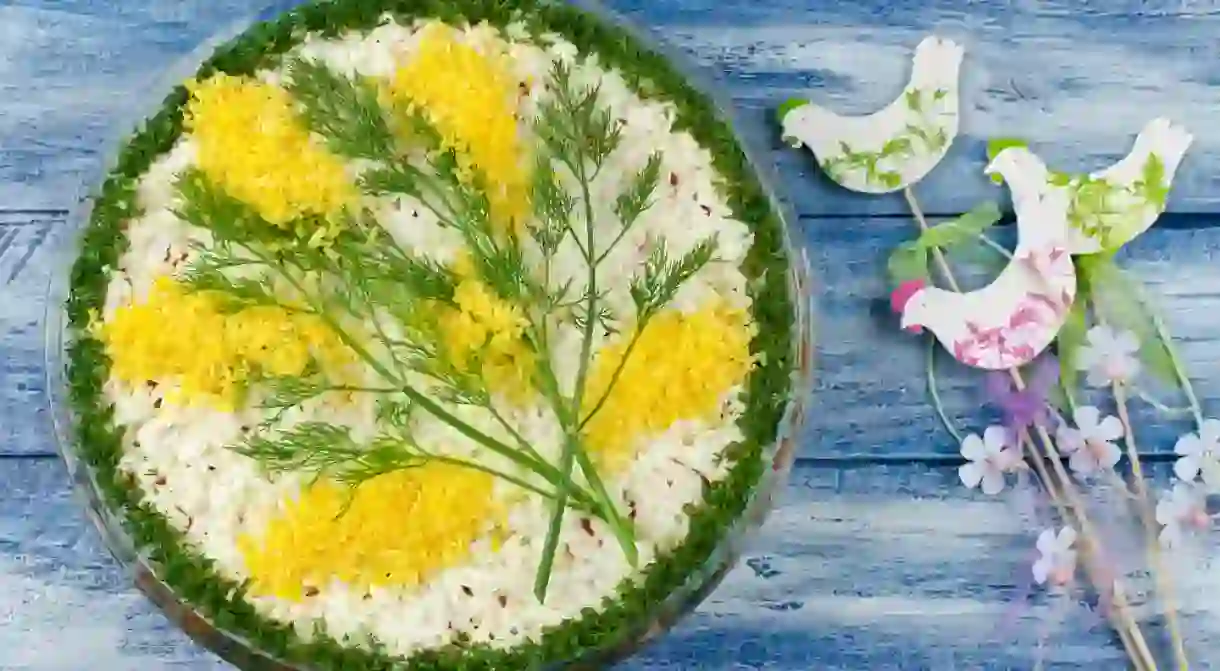11 Delicious Russian Salads You Should Try

Historical food shortages, Soviet austerity and a severe climate have all influenced the Russian salad style. While most dishes share items on the ingredient list, each one manages to be unique. Develop a hankering for root vegetables and a taste for mayonnaise with these delicious Russian salads you should try.
Vinegret
The origin of vinegret actually comes from a miscommunication. The end of the 18th century saw French cuisine influence the Russian plate, and the name of the salad comes from the classic French dressing, vinaigrette. Somewhere along the line, a domestic servant labelled the salad – not the dressing – as vinegret, and it stuck. While commonly made with beetroot, potatoes, cucumbers and beans, the name refers to the small dicing of all the ingredients, rather than the ingredients itself.
Olivier Salad
The most famous of all Russian salads, the Olivier is often referred to as the Russian Salad. Before Soviet times, it was a lavish, French-inspired dish made with grouse, tongue, crayfish, potatoes and cornichons, and drizzled with a Provençal dressing. It was reinvented during Soviet times with canned peas, boiled eggs and bologna, which were then covered in mayonnaise.

Mimosa Salad
Another fish-based salad, a mimosa salad will work with any oily tinned fish, such as mackerel, pilchards or sardines. Mix together grated boiled eggs with onions and carrots, add the mayonnaise and then serve. The salad was created during Soviet food shortages when the State relied on tinned fish to feed its people. Taking its name from the mimosa flower, which shares the same yellow as the grated yolks, it quickly became popular and was the salad that was made on special occasions.
Shuba
Otherwise known as ‘herring under a fur coat’, this is another iconic Russian dish. A layered salad, it covers chopped up herring with scalded onions, then layers of boiled and grated potato, carrot and then beetroot. Each layer is separated by a coating of mayonnaise. Herring salad had been served as an entrée since pre-Soviet times; however, the dish was given its layered stylings sometime in the 1960s by an unknown chef.

Summer Salad
Being a lighter salad than most on the list makes it perfect for a country picnic or a light summertime lunch. Chop tomatoes, cucumbers and green onions and mix them together. The dressing is made from sour cream and dill; however, if you substitute the sour cream with yoghurt, you’ll get a lighter meal while retaining the tang.
Squid Salad
Even though there are hardly any vegetables in this salad, it still qualifies as one. Squid found its way onto the Soviet plate somewhere in the 1960s as it was nutritious and easy to freeze, tin or dry out. Fresh squid and onions are finely sliced and then scalded with boiling water. This is then mixed up with boiled eggs, mayonnaise and salt and pepper. If you think this is lacking in the vegetable department, common additions are cucumber, sauerkraut, potato or canned corn.
Tashkent Salad
Tashkent salad is an Uzbek-based dish that was introduced into the wider Soviet Union after WWII. It is fried onion, thinly sliced green radish, strips of boiled beef and boiled eggs mixed together and slathered with mayonnaise. The dish was created to bridge the gap between the republic and Soviet Russia’s cuisines when the State began to promote the dishes of the Soviet republics around the USSR.

Crab Meat Salad
Since this is another salad that is quick to make and goes down well, the salad is often on the table for celebrations and festivities. Dice up crab meat (usually it’s just made from crab stick), add a few chopped up boiled eggs, add a can of corn, and some peas and carrots, then mayonnaise and mix it all up. Variations include adding some rice to the mix or horseradish to the mayo.
Aubergine Caviar
Known as poor man’s caviar, aubergine caviar was readily available from the 1960s to the 1980s, despite being shunned by the majority of Russians. Another dish born out of food shortages and egalitarian cuisine, this vegetable spread is not too dissimilar from the Middle Eastern baba ganoush and uses roasted peppers and eggplant pulp as its base, which is then flavoured by spices. Serve as an accompaniment to meat and fish or as an appetiser.

Sauerkraut
Sauerkraut is common throughout Eastern Europe. Its tangy bite has been cutting through wintertime stodge for centuries. The Soviet Union was hit with massive food shortages and famine as battles raged across the nation during WWII, and the pickled cabbage provided much-needed nutrients to an undernourished workforce. Wearing rubber boots, female workers would make it in 15-tonne tanks by stomping on the cabbages to release the enzymes and juices.
Carrot and Apple Salad
Another light and refreshing salad, this one is popular with Russian children. It’s also really healthy and full of antioxidants and vitamins. Use a sharp green apple in the salad, like a Granny Smith. Grate the apple and carrots together. For a bit of crunch, add some walnuts or sunflowers, and some raisins for a little bit of sweetness. Then, dress it with a bit of oil, some lemon and honey, and enjoy.













